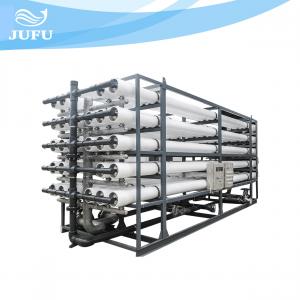100TPH RO Water Filter Equipment Purifying Water Filtration Plant
Add to Cart
100TPH RO Water Filter Equipment Purifying Water Filtration Plant
Advantages of reverse osmosis system:
Reverse osmosis (RO) is a high efficiency and energy saving
technology. It relies on pressure to separate water and ions for
purification and concentration. The process has no phase change,
generally does not need heating, low energy consumption, has the
advantages of low operating cost, no pollution, convenient
operation and reliable operation, high water quality, and has
become the most energy-saving technology of seawater and brackish
water desalination. Has been widely used in medicine, electronics,
chemical, food, seawater desalination and many other industries.
Reverse osmosis technology has become the preferred water treatment
technology in modern industry. Reverse osmosis (RO) technology has
become an important part of membrane separation technology.
Technical specifications for RO Water Treatment System
| Model | JFRO-100T |
| Host Size | 7200x2000x2200mm (can be customized) |
| Power | 110KW |
| Power Supply | 220V / 380V / 460V - 50Hz/60Hz,220V 50Hz can be customized |
| Operating Pressure | 1.2-1.5MPa |
| Recovery Rate | 75% |
| Designed Water Inlet | 135t/h |
| Outlet Flow | 100t/h |
| Desalination Rate | ≥99.5% |
| RO Frame | SUS304/Carbon Steel (Optional) |
| Membrane Size | 8040 |
| Membrane Elements | DOW /Hydranautics/Troy/ Vontron (Optional) |
| Number of Membranes | 108 |
| Raw Water Pump | CNP/NYP/GRUNDFOS (Optional) |
| High Pressure Pump | CNP/NYP/GRUNDFOS (Optional) |
| Tank Material | SS/FRP(Optional) |
| Control Valve | Manual/Automatic |
| Control Valve Brand | FLECK/RUNXIN |
| Membrane Housing | FRP |
| Number of Membrane housing | 18 |
| Pipe Material | U-PVC/ Stainless steel (Optional) |
Process flow of RO Water Treatment System
Raw water → original water tank → original water pump → multi-media filter (quartz sand filter)→ activated carbon filter → soft water processor → precision filter → high pressure pump → first stage reverse osmosis (RO) device → pure water tank → high pressure pump → second stage reverse osmosis → ultraviolet sterilization device → water point
There are two ways to clean reverse osmosis equipment, online cleaning and offline cleaning.
First, online cleaning:
Online cleaning refers to the overall cleaning of the reverse
osmosis device, membrane components do not have to take out the
pressure vessel, usually designed and used in a larger system. This
cleaning method is simple and convenient to operate, short time,
but easy to cause cleaning is not complete, the effect is not
ideal. This method can be used when the contamination of the
reverse osmosis unit is light.
Two, off-line cleaning:
Off-line cleaning means that the membrane elements are removed from
the reverse osmosis pressure vessel and loaded into the special
cleaning equipment for cleaning, usually no more than 6 pieces at a
time. This cleaning method is simple and convenient to operate,
clean thoroughly, the best effect. But more membrane elements,
cleaning time is longer. This method can be used when the reverse
osmosis pollution is serious or the online cleaning effect is poor.
FAQ:
1. What are the inlet water quality requirements for ro water treatment system membrane components?
Items | NTU | SDI | Residual chlorine(mg/L) | Fe2+(mg/L) | TOC(mg/L) |
| Limits | ≤1 | ≤5 | ≤4 | ≤3 |
2. What is the material of ro water treatment system membrane?
Acetate membrane (CA) : mainly because of its resistance to chlorine, so it is still durable. But its suitable pH range is small, easy hydrolysis
Aromatic polyamide membrane (PA) : water almost can not have chlorine, only through a variety of pretreatment chlorine.
3. RO water treatment system configuration?
First-stage multi-stage process: if the recovery rate is not achieved in the first stage (50-65% in the first stage and 65-75% in the second stage), the multi-stage tandem filtration can be used. The effective cross-sectional area of each segment decreases. 2:2 and 2:3 and 4:2:1
Multi-stage process: when the first stage process cannot meet the effluent quality requirements (the first stage is generally ≤20μs/cm), the product water of the first stage process is sent to another reverse osmosis unit.
The arrangement of membrane components can be divided into series and parallel




